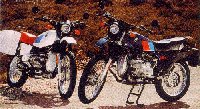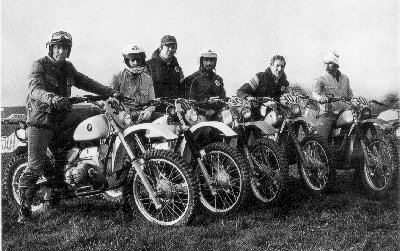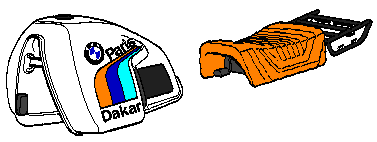 |
 |
The BMW R G/SThe Monolever generation |
 |
The 1980-1987 R 80 G/S

 The first of September 1980, in Avignon (a southern French city), a new type of bike is born. The first big trail bike is on the market. It is the G/S, where G is for Gelände ("offroad" in German motorcycle vocabulary) and S for Strasse ("street" in German).
The first of September 1980, in Avignon (a southern French city), a new type of bike is born. The first big trail bike is on the market. It is the G/S, where G is for Gelände ("offroad" in German motorcycle vocabulary) and S for Strasse ("street" in German).
This bike, with a mono arm rear suspension called Monolever, is the result of the numerous years of experience of the BMW engineers. It is derived from:
- the R series touring motor bikes
- the "Six days" enduro prototypes:

The BMW enduro team of 1979 (R.Witthöft, L.Perez, D.Beinhauer, K.Fischer, H.Schek, R.Schalber)
The principal qualities of the R 80 G/S :
- a very low weight for a big trail bike (191 kg)
- the strong and "tireless" (if we watch the oil level) boxer (or flat-twin) engine of the BMW bikes R series.
- Engine: 798 cm³, 84,8mm x 70,6mm, 50 hp (37 kW DIN) at 6500 rpm, 56,7 Nm at 5000 rpm, Compression: 8,2:1, 32mm Bing carburators, 5 speeds.
- a good load capacity
- a large number of optional parts (bags, tank,...)
Technical info
The monolever
 The mono suspension arm contains the drive shaft. The system is enclosed with oil inside to lubricate the shaft. The shock absorber is only on the right side and goes from the frame to the final drive.
The mono suspension arm contains the drive shaft. The system is enclosed with oil inside to lubricate the shaft. The shock absorber is only on the right side and goes from the frame to the final drive.
The swingarm is now fatter and round because it has to resist the twisting that is a result of only being on one side. Inside the final drive, the wheel is bolted to the ring gear with three studs and lug nuts.
Electrical wiring diagram
The R 80 G/S lineage
 The rare R 80 ST, a road oriented R 80 G/S, may be the best twisty road bike BMW ever built. The differences between a R 80 G/S are:
The rare R 80 ST, a road oriented R 80 G/S, may be the best twisty road bike BMW ever built. The differences between a R 80 G/S are:
- the original chrome engine protection bars
- a stainless steel exhaust with a black cover plate
- the left side panel (which can create problems for mounting luggage racks made for the G/S)
- smaller chrome-plated handlebars
- a larger oilpan (standard road model) and no bash plates;
- no kickstarter
- the wheels : 100/90 H 19 and 120/90 H 18 (instead of 90/90 T 21 and 130/80 T 18)
- a compression ratio of 8,0:1 instead of 8,2:1
- a rear shock with smaller travel (153 mm vs. 170 mm);
- the front of an R 65 : (headlight, console, mudguard and forks with
small modification (a rebound spring that the R 65 doesn't have)
- the tank (R 65 style) and tank cap;
- the weight : 198 kg
- and beautiful metalic (crimson red or grey) paint with white stripes
The racing prototypes used in the Paris-Alger-Dakar rallies.
R 80 G/S Paris Dakar
In 1984, BMW present the first "Africa" enduro bike, the R 80 G/S Paris Dakar. The differences vs. a R 80 G/S are:
- a bigger steel tank (32 lit./8.9 gal.) with Gaston Rahier's signature on it
- a solo seat with a fixed luggage rack (to get under the seat, all the seat/rack unit have to be removed)
- no plastic side panel (the battery is visible)
- a stainless steel exhaust with a black cover plate
- a 12v/20Ah battery in place of a 12v/16Ah
- the weight : 205 kg
- engine torque value of 58 Nm at 4000 rpm vs: 56,7 Nm at 5000 rpm
R 65 GS
During the period 87-90 (life time of the first version of the Paralever GS), the first G/S version continues with a smaller engine (650 cm³, 82mm x 61,5mm, 27 hp (20 kW DIN) at 5500 rpm, 43 Nm at 3500 rpm, Compression: 8,4:1, 2 Bing carburators 26mm, 5 speeds), it's the R 65 GS. It is exactly like the R 80 G/S except for the chrome exhaust, the GS mirror, the battery (12v/20Ah vs: 12v/16Ah) and the weight : 198 kg.
Updated November 2009







![]() The first of September 1980, in Avignon (a southern French city), a new type of bike is born. The first big trail bike is on the market. It is the G/S, where G is for Gelände ("offroad" in German motorcycle vocabulary) and S for Strasse ("street" in German).
The first of September 1980, in Avignon (a southern French city), a new type of bike is born. The first big trail bike is on the market. It is the G/S, where G is for Gelände ("offroad" in German motorcycle vocabulary) and S for Strasse ("street" in German).
 The mono suspension arm contains the drive shaft. The system is enclosed with oil inside to lubricate the shaft. The shock absorber is only on the right side and goes from the frame to the final drive.
The mono suspension arm contains the drive shaft. The system is enclosed with oil inside to lubricate the shaft. The shock absorber is only on the right side and goes from the frame to the final drive.![]() The rare R 80 ST, a road oriented R 80 G/S, may be the best twisty road bike BMW ever built. The differences between a R 80 G/S are:
The rare R 80 ST, a road oriented R 80 G/S, may be the best twisty road bike BMW ever built. The differences between a R 80 G/S are:

